The precedent had been established that the winner and runner-up of the ECAC Tournament would receive invitations to the NCAA Tournament. Two exceptions existed to the invitation of Eastern runners-up. St. Lawrence finished second to Providence College in the 1964 ECAC Tournament. The Saints were passed over for the Engineers of RPI when the NCAA selection committee convened.
Similarly, Cornell had lost to Clarkson in the final game of the 1966 ECAC Tournament. The Big Red was not invited to the national tournament. A dispute between the Ivy League and the NCAA regarding academic eligibility and standards precluded the invitation of Cornell. Harkness and his team needed to decline the invitation to the Tournament. His veterans of the 1966-67 team and he had waited one year for the chance to compete for a national championship.
Ned Harkness had a simple pitch to his recruits when he identified them. The legendary coach would tell them that they could earn a practical degree that would help them when they returned to their former lives. The path from college hockey to the professional ranks was untrodden at that time. Most players who played in college would find their employments in fields other than athletics. Many would return home to inherit their families's farms. Harkness sold the educational opportunities of the College of Agriculture and Life Sciences of Cornell University as a means to play a very high level of hockey while earning a degree that would serve them in adulthood.
His second promise was that he would lead his players in bringing a national championship back to Cornell. The allure of such an accolade drew Dave, Doug, and Robert Ferguson to the Ivy of Upstate New York. It was the boldness of this pledge that drew Ken Dryden from the Ivy-covered walls of Princeton University to those of Cornell University. The Fergusons were seniors. They had only one year remaining to win the national championship. The field between Cornell and its first national championship in hockey was a challenging one.
The 1967 NCAA Tournament consisted of Boston University, Cornell, Michigan State, and North Dakota. Boston University earned its bid to the national tournament largely by virtue of finishing second to Cornell in the 1967 ECAC Tournament. The Terriers had been impressive during the 1966-67 season and gave the selection committee no reason to bypass them. Michigan State and North Dakota were both members of the WCHA.
Michigan State had earned its berth to the national tournament in an unexpected way. The Spartans began the 1966-67 season as the defending national champions. They had defeated Boston University and Clarkson to win their first national title in 1966. Michigan State was floundering during the 1966-67 season. The team from East Lansing finished fifth in the WCHA during the regular season. The Spartans found a way to win the 1967 WCHA Tournament with a surprising overtime win over the Huskies of Michigan Tech. That victory afforded the Spartans and Amo Bessone the opportunity to defend their national title.
The Fighting Sioux of North Dakota extended their season with consistent regular-season play that saw them winning the MacNaughton Cup of the WCHA. North Dakota defeated archrival Minnesota and Denver in the 1967 WCHA Tournament to reinforce its resume. The Sioux were national champions in 1959 and 1963.
Cornell boasted the best record among the top four teams in the nation. The Big Red had compiled a 25-1-1 record before the national tournament. Cornell's 0.944 winning percentage dwarfed those of the other three participants. Boston University owned the second-best record of the 1967 national-tournament field. The Terriers had produced a 24-4-1 record. Michigan State and North Dakota of the WCHA had the poorest records. The Fighting Sioux carried with them a 19-8-0 record. Michigan State earned a modest 0.517 winning percentage with a 15-14-1 record before the 1967 NCAA Tournament.
Boston University and Cornell had squared off two times before the national tournament. The first meeting saw Harry Orr, Robert Ferguson, and Walt Stanowski score three goals in the second period to erase a 2-1 lead for the Terriers. Boston University was able to tie the game and defend the stalemate with less than five minutes remaining in the contest. Dryden had made 40 saves to ensure that Cornell preserved the tie. The second meeting between the Big Red and Terriers was in the ECAC Championship Final. Three third-period goals for Cornell in that contest propelled Cornell to its first championship.
The other opponent in the national tournament that Cornell had played was Michigan State. The Spartans participated in the ECAC Holiday Tournament at Boston Garden in December 1966. Robert Ferguson scored a first-period goal for the Big Red. Dave Ferguson added a power-play goal late in the second period. Michigan State knotted the game in the third period behind a power-play and shorthanded goal. Mike Doran ended the contest less than one minute into overtime.
Cornell was familiar with two-thirds of its possible opponents in the field for the 1967 NCAA Tournament. The only possible opponent that Cornell had not played that season was North Dakota. The first opponent for Cornell in the NCAA Tournament in program history would be the Fighting Sioux of North Dakota.
The crowd at the Onondaga War Memorial was partisan in Cornell's favor. Many from the crowds that had filled Lynah Rink during the season made the short trip from East Hill to Syracuse. The statistical balance of history on the ice weighed toward the opposite end. The Sioux had appeared in five of the first 20 NCAA Tournaments. The senior class of the North Dakota roster that took the ice against the 1966-67 team from Cornell competed in the 1965 NCAA Tournament. This was the first time that Cornell would seek an NCAA national title in hockey.
Ned Harkness reassured his skaters that they were ready for the test from their Western opponent. Bill Selman stood behind the bench for North Dakota and assured his players that they had not climbed their way back into the national tournament to have another Eastern team deny them a chance at a national championship. Cornell may have boasted the older hockey program by more than three decades, but it was the Fighting Sioux who felt they had the assurance that history only can bring. Traditions were about to collide.
North Dakota had expected the upstart Cornell squad to be rattled. It was not. The skaters for the Big Red were calm and composed. They were as sincere about their intentions and as gritty as their coach. The carnelian and white battled the green and white of North Dakota. A physical battle ensued. Cornell was indomitable.
Cornell controlled the game early. The Big Red battled the fierce Fighting Sioux in the corners. Surprising to some was that Cornell would challenge more relentlessly North Dakota's netminder than the Western foe would challenge Ken Dryden. What was even more surprising was that both netminders appeared more than up to the task.
The seconds and minutes of the first period ticked away. Lefty Curran had an answer for each Red salvo. Dryden would answer with his own characteristic poised panache in denying each North Dakota challenge. Five minutes elapsed like this. Ten minutes passed. Then 15 minutes had passed.
Both teams appeared content to go into the first intermission with the game deadlocked in Central New York. Three Cornellians had something else in mind. The 17-minute mark passed. Pete Tufford and Bob McGuinn combined to find Walt Stanowski. The junior who wore number three bested the Sioux's Curran who had seemed invincible just moments before the puck from his stick rippled the twine of the net. Stanowski began to show to Cornell what Harkness had told them all along: Cornell could compete with the best on the grandest stages.
The final 1:33 of the first period expired. Cornell had taken a hard-fought 1-0 lead. Ned Harkness implored them not to relent. Selman of North Dakota motivated his team. The Fighting Sioux retook the ice in the second period with a determination to assert their control of the game. Cornell had outshot North Dakota 12 shots to eight shots in the first 20 minutes. The second period would be very different.
The combativeness and dominance of Cornell did not recede. North Dakota became more assertive. The second stanza of the contest became balanced. Cornell would challenge Curran. The Western netminder continued to backstop North Dakota superbly. Ken Dryden began to get challenged equally. He elevated his phenomenal game to protect Cornell's often precarious 1-0 lead.
Both netminders held the skaters on the ice scoreless in the second period. Both Cornell and North Dakota attempted to solve their opponent's netminder 13 times in the second period. No attempts were successful. The first NCAA Tournament game for the Big Red had become a duel of goaltenders. Dryden was up to the challenge.
Dryden had not lost a game in his collegiate career. He was determined not to allow his first loss to end his sophomore season. The towering netminder had been in four previous games that had been decided by one goal. He had backstopped Cornell to victory in all of those contests. He would not stop in the national semifinal game.
North Dakota withered somewhat after the second intermission. Cornell would outshoot the Fighting Sioux by almost a two-to-one margin. Lefty Curran delivered a phenomenal performance to give his team a chance to advance to the national title game for the first time in four years. His play was not enough because Cornell's Ken Dryden was delivering a flawless performance 178 feet down the ice.
Bill Selman pulled Curran with one minute remaining in the contest. North Dakota challenged several times in the waning 60 seconds. Dryden and Cornell were as resolute in the final minute of the contest as they had been in the previous 59 minutes. Dryden would deliver the shutout and Cornell would preserve it. Cornell advanced to the national title game for the first time with a 1-0 victory after a spectacular performance from its netminder and unyielding checking.
Cornell advanced to the national championship game. The team would receive a well-deserved day off between the national semifinal contest and championship game. Boston University had denied the Spartans of Michigan State the opportunity to defend their national title in the final game of the season. The Terriers recorded a 4-2 victory. This result guaranteed Cornell a meeting for the national title with familiar and loathed Boston University.
The championship game of the 1967 NCAA Tournament took place exactly one week after Boston University and Cornell sparred for the ECAC Championship. The contest a week prior had been a close one. The roar of the crowd at Boston Garden was in favor of the local Terriers. The 1966-67 Terriers had not played a game in front of a Cornell-dominated audience. Each of the season’s previous meetings of the archrivals had been in Boston. It was now time for the Terriers to skate in the territory of Cornell and the Lynah Faithful.
The ice was covered in sweaters of carnelian and white, and scarlet and white. Three famous coaches were nvolved in the contest between Boston University and Cornell. Ned Harkness readied his men to achieve their lofty goal. Jack Kelley motivated his roster with hopes of revenge. Future college hockey coach Jack Parker skated on the ice for the Terriers.
The game guaranteed a historic result. Neither Boston University nor Cornell had entered the elite ranks of national championship-winning programs. Boston University had appeared in one national-title game. That appearance occurred when Jack Kelley was lacing his skates up to play for Boston University. No Terrier had played on this stage. The meeting represented the first time since 1949 that the NCAA Championship Final was guaranteed to yield a champion from the East.
Most spectators anticipated another stifling performance from Cornell. The prowess, reputation, and experience of a tested North-Dakota team neither phased nor daunted Cornell in the national semifinal contest. An in-conference opponent should have given Cornell a greater sense of ease. No such ease was present. The angst that was noticeably absent in the first contest for Cornell crept into the early moments of the national title game.
Boston University took control of the game in the first moments of the game. The Terriers seemed to control the zone and unleash several challenges to Ken Dryden. Dryden continued where he had ended his performance in the semifinal contest. He helped his team weather the rough early minutes of the contest. He answered what seemed like challenger after challenger. Only one minute had expired.
Cornell managed to establish a presence in the territory of the Terriers. Bob Kinasewich channeled the efforts of Murray Death and Walt Stanowski into a goal. Wayne Ryan was stunned. Boston University had such a commanding start that it did not expect the unseasoned Cornell to strike so easily. One can imagine Dryden taking his characteristic pose as he peered down the ice waiting for play to resume. He had made one goal the difference two nights before. He could do it again if he needed. He would have no need.
The balance of the game favored Cornell. Walt Stanowski tallied a goal during a power-play opportunity late in the first period. Dryden ensured that the nine shots of the Terriers did not threaten to spoil Cornell's bid for a shutout in the first period. The second period witnessed Boston University asserting its control into the game. The physical play of Harkness' squad and the astounding precision of Ken Dryden kept a surging Terriers squad from marring Cornell's clean sheet in the first half of the second period.
Doug and Dave Ferguson connected for a power-play goal with 7:19 seconds remaining in the second period. Doug Ferguson had given the Big Red a commanding 3-0 lead just past halfway through the game. The Terriers refused to be tamed. They answered 12 seconds later. They did what no other team in the 1967 NCAA Tournament could do: solve Dryden.
Boston University had just over seven minutes to erase a two-goal deficit against an imposing and disciplined team with a hot goaltender. The Terriers had tallied three goals against Cornell in the 1967 ECAC Championship game. They would need to do it again. The second period ended. Time waned on Boston University's chance to reassert itself into the game. The Cornellians were on the verge of becoming national champions.
The waves of challenges from Boston University did not abate. Cornell was outshot by a final shot ratio of 20 to 32. Cornell and Dryden remained unsolvable. Bob McGuinn added a fourth goal for Cornell in the final ten minutes of the final game of the season. Walt Stanowski provided a helper in what was his third point of the game. Ken Dryden delivered 41 saves.
A contest that began with Cornell demonstrating tepidity and insecurity developed into a stunning display of dominance. The game was never in question. The high-water mark for Boston University was its lone goal in the second period. Cornell controlled the game with its methodology and discipline.
Fittingly, the goal that clinched Cornell's first national championship belonged to Walt Stanowski. The junior defenseman from Willowsdale, Ontario contributed in some manner to four of the five goals that Cornell scored in the 1967 NCAA Tournament. These efforts earned his recognition as the most valuable players of the national tournament.
Sophomore Ken Dryden was not to be outdone by one of his blueliners. The indomitable netminder produced a goals-against average of 0.500 and a save percentage of 0.986 during the 1967 NCAA Tournament. The college-hockey world had begun to expect the extraordinary from the netminders of East Hill.
Ned Harkness addressed the crowd after his team was victorious in a ceremony that has become customary. The emotional coach in his speech remembered his father who had served as coach of the freshman teams at Cornell University until his death in 1964. The coach spoke into the microphone and recalled how his father predicted that the freshmen whom he coached to an undefeated 1963-64 were "going to be national champions." Ned Harkness remarked fondly that "Pop would have been proud of these boys." Two promises were fulfilled.
As Ned Harkness, Murray Death, and Dave Ferguson gathered at center ice to receive the simple, iconic silhouette of the wooden national-championship trophy, they should have reflected upon how historic their accomplishment was. Cornell had become only the third Eastern program to win a national championship. Harkness had earned another championship for the East in 1954 when he was the bench boss at RPI. Cornell became only the ninth program to win an NCAA national championship. It was the first NCAA championship that any team brought back to East Hill. It was the first NCAA championship in a team sport other than fencing and skiing that an Ivy-League program had won.
The most noteworthy accomplishment of the national title was the manner in which Cornell had won. The efforts of the 1966-67 team epitomized Cornell hockey. The team played a determined, responsible, and grueling game with an extreme emphasis upon defense and goaltending. Furthermore, the victory represented a win for the ethos of Cornell University.
Cornell University was the only Ivy-League institution founded upon meritocratic egalitarianism. The mission of the University was to educate the children of the agrarian and industrial classes. It is only fitting that the University's first NCAA national championship was won in a sport characterized often as blue collar. The champions who coached and won this first national title were the embodiment of an institutional mission. They had achieved great things from humble origins.
Ned Harkness had kept his promise to the Fergusons, Ken Dryden, and Cornell University. He had made them national champions. A program of proud history had reemerged on the national stage in a new era and proved itself worthy to reside among the elite of a growing sport. It would become the task of Harkness, his successors, and generations of players to ensure that Cornell hockey remained there. However, that night on March 18, 1967 was for celebration.
Paul Althouse, Brian Cornell, Ted Coviello, Wayne Currie, Murray Death (C), Michael Doran, Ken Dryden (G),
Andrew Crowley, Dave Ferguson (C), Doug Ferguson, Robert Ferguson, James Gately, Robert Kinasewich,
Thomas Kostandoff, Terrence McGlashan, Robert McGuinn, Albert McNaught, Harry Orr, Bruce Pattison,
David Quarrie (G), Kennedy Smith, Walt Stanowski, George Swan (G), James Taverner, Pete Tufford, Richard Wakeman, Murray Watkinson
- Navigate the Rafters -




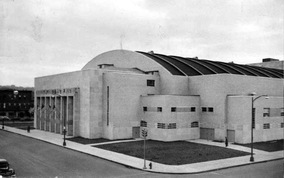
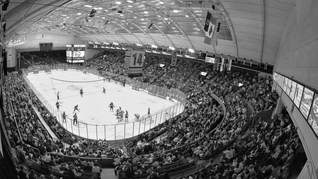
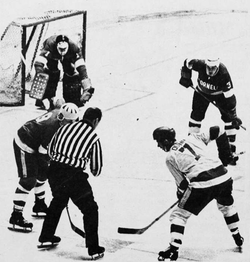
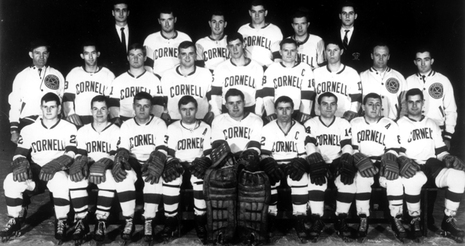


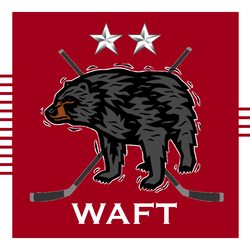

 RSS Feed
RSS Feed
